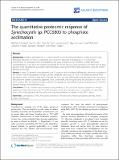Files in this item
The quantitative proteomic response of Synechocystis sp. PCC6803 to phosphate acclimation
Item metadata
| dc.contributor.author | Fuszard, M.A. | |
| dc.contributor.author | Ow, S.Y. | |
| dc.contributor.author | Gan, C.S. | |
| dc.contributor.author | Noirel, J. | |
| dc.contributor.author | Ternan, N.G. | |
| dc.contributor.author | McMullan, G. | |
| dc.contributor.author | Biggs, C.A. | |
| dc.contributor.author | Reardon, K.F. | |
| dc.contributor.author | Wright, P.C. | |
| dc.date.accessioned | 2014-08-26T16:31:00Z | |
| dc.date.available | 2014-08-26T16:31:00Z | |
| dc.date.issued | 2013-02-26 | |
| dc.identifier | 143505960 | |
| dc.identifier | 747c1246-e800-406e-a38b-e0788bd0b12f | |
| dc.identifier | 84875076480 | |
| dc.identifier.citation | Fuszard , M A , Ow , S Y , Gan , C S , Noirel , J , Ternan , N G , McMullan , G , Biggs , C A , Reardon , K F & Wright , P C 2013 , ' The quantitative proteomic response of Synechocystis sp. PCC6803 to phosphate acclimation ' , Aquatic Biosystems , vol. 9 , no. 1 . https://doi.org/10.1186/2046-9063-9-5 | en |
| dc.identifier.issn | 2046-9063 | |
| dc.identifier.uri | https://hdl.handle.net/10023/5242 | |
| dc.description | The authors wish to acknowledge the provision of an EPSRC studentship, Advanced Research Fellowship for CAB (EP/E053556/01) and further EPSRC funding (GR/S84347/01 and EP/E036252/1). | en |
| dc.description.abstract | Background: Inorganic phosphate (P) is a critical nutrient for all life and is periodically limiting in marine and freshwater provinces, yet little is understood how organisms acclimate to fluctuations in Pi within their environment. To investigate whole cell adaptation, we grew Synechocystis sp. PCC6803, a model freshwater cyanobacterium, in 3%, and 0.3% inorganic phosphate (Pi) media. The cells were allowed to acclimate over 60 days, and cells were harvested for quantitative high throughput mass spectrometry-based proteomics using the iTRAQ™ labelling technology. Results: In total, 120 proteins were identified, and 52 proteins were considered differentially abundant compared to the control. Alkaline phosphatase (APase) activities correlated significantly (p <0.05) with observed relative PhoA abundances. PstS1 and PstS2 were both observed, yet PstS1 was not differentially more abundant than the control. Phycobilisome protein abundances appeared to be coordinated, and are significantly less abundant in 0.3% Pi than 3% Pi cultures. Also, the central metabolic cell function appears to have shifted towards the production of (NADPH) reducing energy and nucleotide sugars. Conclusions: This acclimation response bears strong similarity to the previously reported response to nitrogen deprivation within Synechocystis sp. PCC 6803. However, it also demonstrates some characteristics of desiccation stress, such as the regulation of fatty acids and increased abundance of rehydrin in the 3% Pi culture. | |
| dc.format.extent | 12 | |
| dc.format.extent | 582240 | |
| dc.language.iso | eng | |
| dc.relation.ispartof | Aquatic Biosystems | en |
| dc.subject | Cyanobacteria | en |
| dc.subject | iTRAQ | en |
| dc.subject | Phosphate acclimation | en |
| dc.subject | Phycobilisome | en |
| dc.subject | Pentose phosphate pathway | en |
| dc.subject | Ribose sugars | en |
| dc.subject | Synechocystis | en |
| dc.subject | QD Chemistry | en |
| dc.subject | SDG 14 - Life Below Water | en |
| dc.subject.lcc | QD | en |
| dc.title | The quantitative proteomic response of Synechocystis sp. PCC6803 to phosphate acclimation | en |
| dc.type | Journal article | en |
| dc.contributor.institution | University of St Andrews. School of Chemistry | en |
| dc.identifier.doi | https://doi.org/10.1186/2046-9063-9-5 | |
| dc.description.status | Peer reviewed | en |
| dc.identifier.url | http://www.scopus.com/inward/record.url?eid=2-s2.0-84875076480&partnerID=8YFLogxK | en |
| dc.identifier.url | http://www.aquaticbiosystems.org/content/9/1/5/additional | en |
This item appears in the following Collection(s)
Items in the St Andrews Research Repository are protected by copyright, with all rights reserved, unless otherwise indicated.

